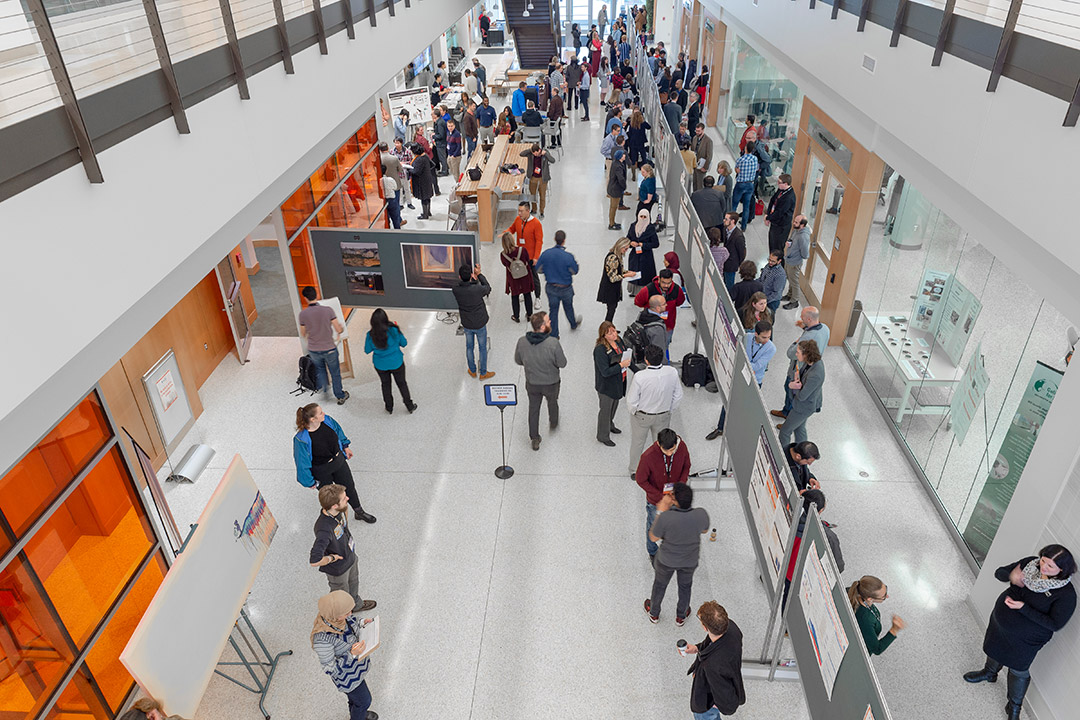RIT Graduate Showcase offers a fresh perspective on research and scholarship
Elizabeth Lamark
RIT master’s and doctoral students displayed their research and scholarship at the 12th annual Graduate Showcase.
The RIT Graduate Showcase symposium highlighted the university’s signature blend of technology, the arts and design, with research topics varying from carbon nanotubes to neutron stars to wooden toys and film. The event—now in its 12th year—has grown with the university’s focus on graduate education.
The quality of scholarship displayed at the showcase “is a testament to RIT’s sense of itself as a student-centered research institution,” said RIT Provost Ellen Granberg at the showcase held Nov. 22. Graduate research at RIT began 30 years ago under RIT President Richard Rose, she noted, who saw opportunities for students and faculty to work together.
RIT’s graduate education is on an upward trajectory. The university’s strategic plan anticipates the addition of 16 to 20 new Ph.D. programs by 2025. At the showcase, Granberg announced the next four potential Ph.D. programs entering the initial proposal phase—business administration, mechanical and industrial engineering, electrical and computer engineering, and biomedical and chemical engineering. Master’s education—“a historic strength at RIT,” Granberg said—will also expand with new degree programs focusing on specialized workforce needs, such as a master’s degree in artificial intelligence.
The expanding graduate culture creates a new dynamic among students seeking advanced degrees, said Twyla Cummings, RIT associate provost and graduate dean. Working together and helping others—including younger students—is an essential part of graduate education.
“Success comes from relationships,” Cummings said.
 Elizabeth Lamark Abigail Rolston, a master’s student in RIT’s environmental science program, shared her findings about biodegradable plastics at the Graduate Showcase.
Elizabeth Lamark Abigail Rolston, a master’s student in RIT’s environmental science program, shared her findings about biodegradable plastics at the Graduate Showcase.Abigail Rolston, an MS student in environmental science from Sodus Point, N.Y., formed a collaboration with the packaging science department to make samples of biodegradable plastics for her to test.
“Instead of cleaning up the mess that is plastic by old recycling methods— we need to change plastic at its core, and that means molecularly into a different material,” she said.
Rolston’s collaborators in the packaging science lab enabled her to collect data about biodegradable plastics that use starch blended polymers as plastic packaging alternatives. They introduced “me into the world of polymers, what it means and the background behind it,” she said. “They’ve been a wonderful, pivotal part of this whole project.”
Research collaborations often extend beyond the RIT campus.
Nicholas Schug, an MS student in chemistry from Syracuse N.Y., explores targeted molecular imaging agents that can be used in conjunction with medical imaging to illuminate cancer cells.
“We make imaging agents that target cancer cells and light up the cells,” he said. “They are like lightbulbs.”
Scientists at Roswell Park Comprehensive Cancer Center in Buffalo, N.Y., are testing a molecule Schug synthesized at RIT.
“It is satisfying,” Schug said. “It could be early detection of cancer.”
Jag Pariti, a Ph.D. student in computing and information sciences from Alberta, Canada, shared his findings from a usability test he conducted for an “intelligent mobility cane” with individuals from the Association for the Blind and Visually Impaired. The cane helps to guide the user through warning vibrations in the handset.
“They found the vibration helped them navigate away from an obstacle,” he said.
The Graduate Showcase gives master’s and Ph.D. students a chance to see what their peers are working on and practice communicating their research.
As a doctoral student, Pariti is immersed in human-computer interaction for accessibility. The showcase gave him an opportunity to learn about research in other areas on campus.
“It’s easy to get so focused and ‘siloed,’ but you can learn what other people are doing—methods or analysis—and adapt it to your own research,” Pariti said.
Rolston pays attention to different ways of presenting and displaying information.
“You’re able to see a lot of other people’s research, and seeing them, you’re able to take a step back and think about how you can present your research better to reach a wider audience,” Rolston said.













